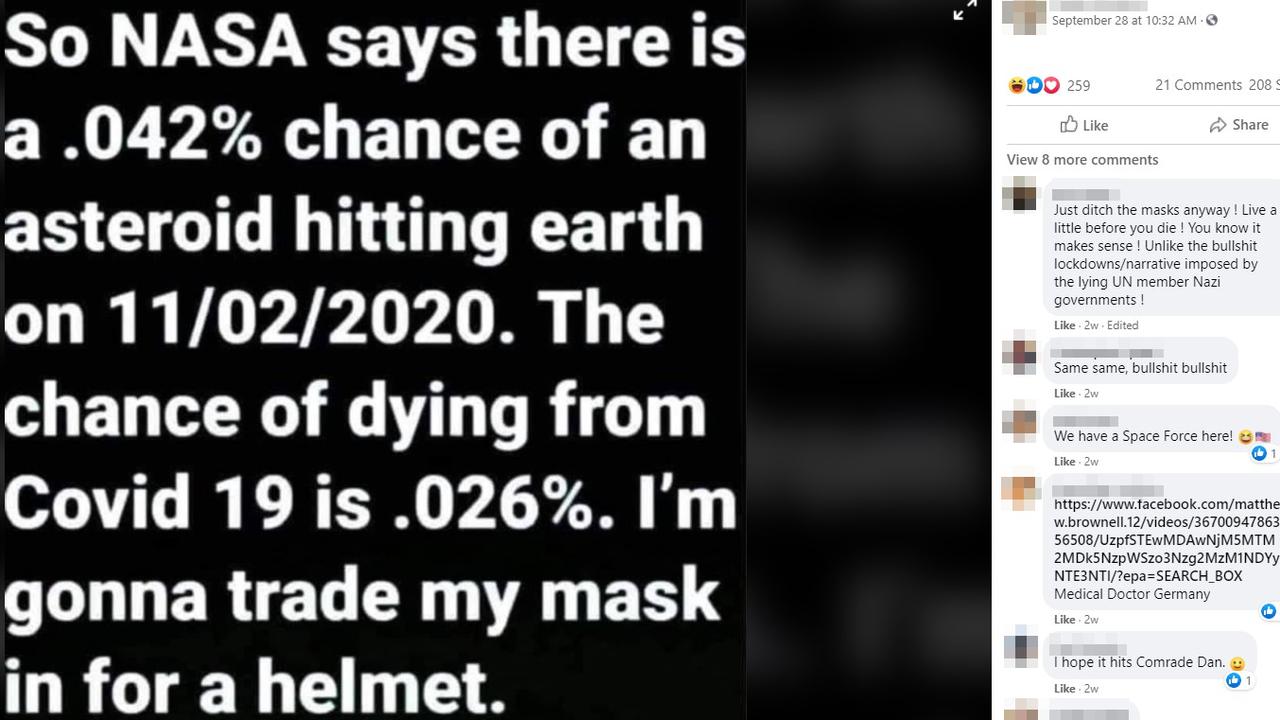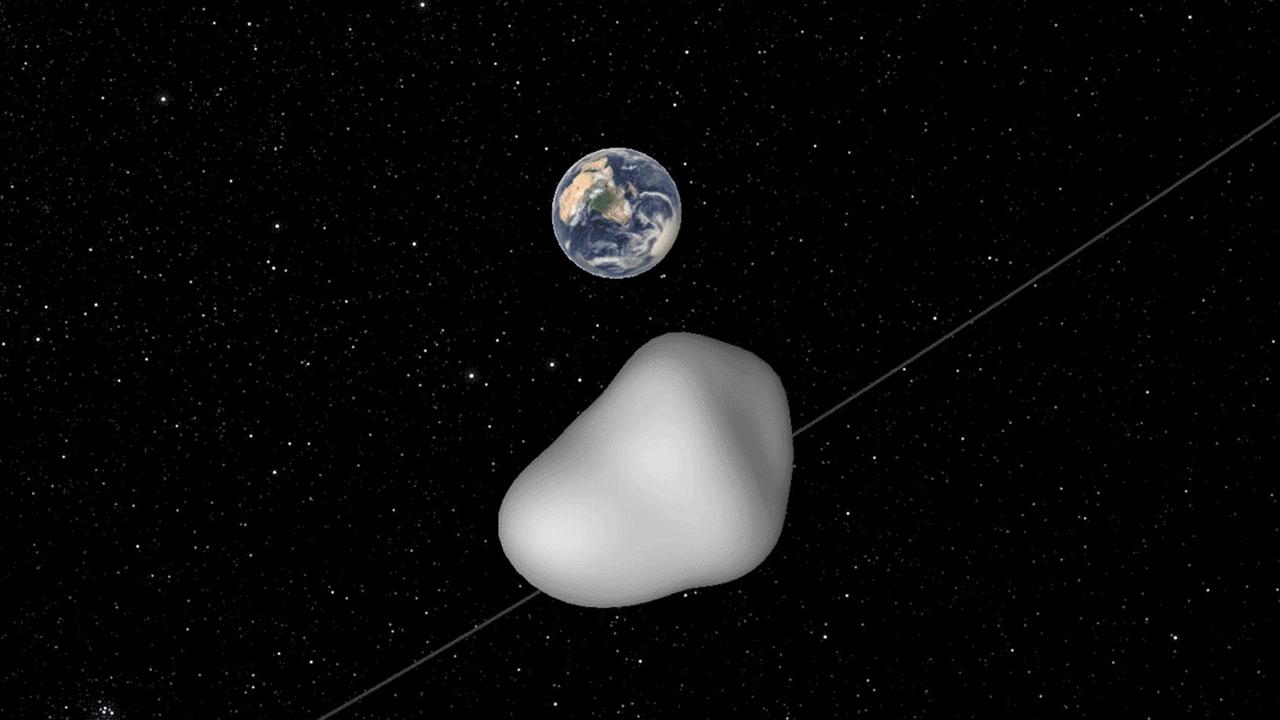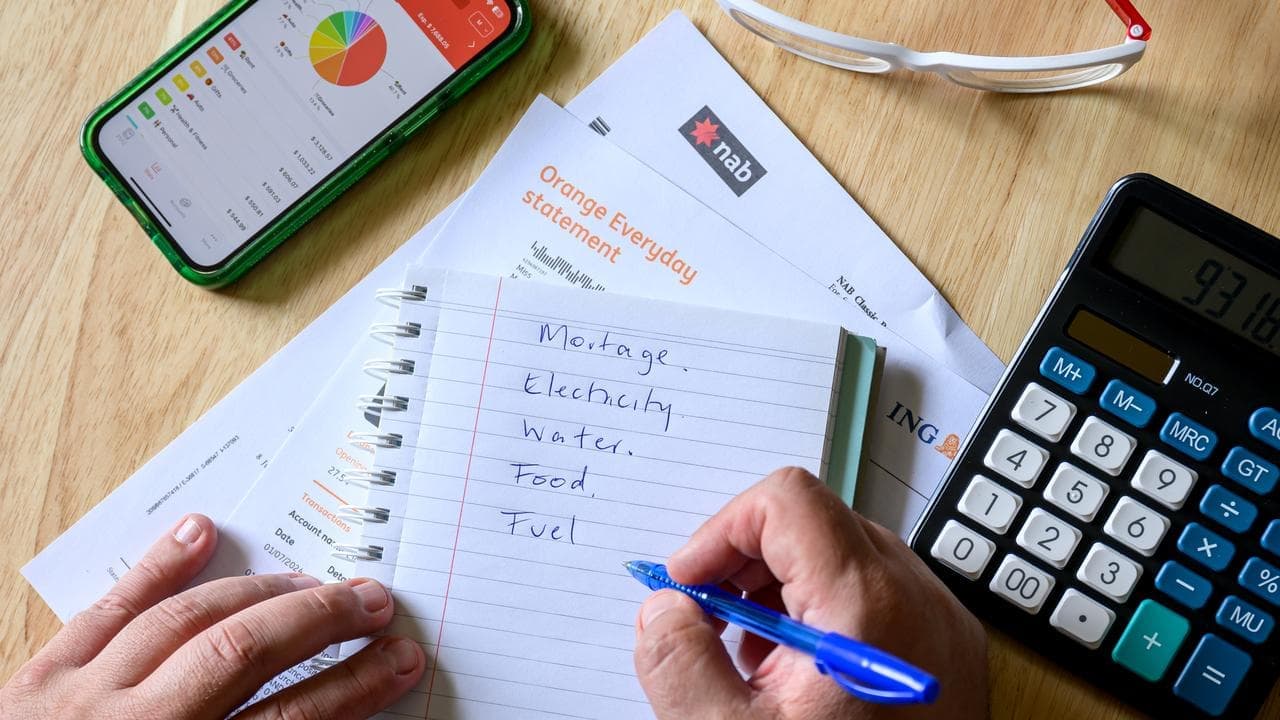The Statement
A social media post claims the chance of an asteroid hitting Earth in November is higher than the chance of dying from COVID-19.
The Facebook post from September 28 includes a meme saying: "NASA says there is a .042% chance of an asteroid hitting earth on 11/02/2020."
It goes on to add: "The chance of dying from Covid 19 is .026%. I'm going to trade my mask in for a helmet."
At the time of writing, the post has been viewed more than 18,000 times, attracting more than 200 shares and 250 reactions.

The Analysis
An asteroid, named 2018VP1, is predicted to approach Earth on November 2, 2020, with a 0.41 per cent chance it will enter the atmosphere, according to NASA. However, the US space agency says there is no chance it will strike the planet's surface intact as it would disintegrate before then.
NASA's Center for Near Earth Object Studies (CNEOS) monitors near-Earth objects (NEO) in space and predicts close approaches to the planet, producing assessments of impact probabilities over the next century.
The center's earth impact monitor says the cumulative "impact probability" for asteroid 2018VP1, which has an estimated diameter of 2 metres, is 0.41 per cent - not 0.042 per cent as stated in the Facebook post.
In a tweet, NASA Asteroid Watch described the object as "very small" and posing no threat to Earth.
"It currently has a 0.41% chance of entering our planet's atmosphere, but if it did, it would disintegrate due to its extremely small size," the tweet said.
Dr Paul Chodas, the director of CNEOS, told AAP FactCheck via email that the Facebook meme was incorrect on several counts and implied danger where there was none.
He said the term "impact probability" as used by NASA meant "impact into the Earth's atmosphere".
"The asteroid in question is extremely tiny which means that even if it does impact, it will disintegrate into dust as it streaks through the atmosphere, producing at most a little shower of small meteorites. There is no chance this asteroid would reach the surface intact."
The post claims the chance of dying from COVID-19 is 0.026 per cent, however it is unclear what this figure represents.
Gideon Meyerowitz-Katz, an epidemiologist from the University of Wollongong, told AAP FactCheck in an email he had never heard a death rate claim of 0.026 per cent which he said was "extremely low and definitely wrong".
There are several ways that the risk of dying from COVID-19 can be assessed. Three key figures are the infection fatality rate (IFR), case fatality rate (CFR) and crude mortality rate (CMR).
IFR measures the number of deaths as a proportion of all COVID-19 infections, including both diagnosed and undiagnosed cases, and can show how likely it is that someone who becomes infected with COVID-19 will die.
It is also increasingly being used as an estimate of the overall mortality from COVID-19 by both policy-makers and the general public, according to a review in the International Journal of Infectious Diseases.
Mr Meyerowitz-Katz told AAP FactCheck it was difficult to arrive at a single accurate figure for IFR, but it had been shown the rate increased exponentially with age - from less than one in 10,000 at age 20 to nearly one in three at 85.
His meta-analysis of IFRs for COVID-19 produced the aggregate figure of 0.68 per cent. This represents the purported chance of anyone who becomes infected with COVID-10 dying as a result of the virus.
In the US, the Centers for Disease Control and Prevention use a "current best estimate" of IFR for planning purposes (table 1) ranging from 0.00003 for those aged under 20; 0.0002 for those aged between 20-49 years; 0.005 for those aged 50-69 years; and for 70+ year age bracket, 0.054.
However, the above figures are ratios, and need to be multiplied by 100 to get a percentage - making it 0.003 per cent for those aged under 20, to 5.4 per cent for people aged 70 and older.
An analysis published in the British Medical Journal (page 1) in August predicted COVID-19 IFRs for 187 countries based on their demographics, likelihood of comorbidities existing and health system capacities. Its estimates ranged from 0.43 per cent for countries in western sub-Saharan Africa to 1.45 per cent in Eastern Europe.
In contrast, CFR is the proportion of deaths among those confirmed as having the illness. The World Health Organization identifies several flaws with the use of CFR as a metric during a pandemic, noting that it is generally used at the end of an outbreak after all cases were resolved.
For example, in counting only confirmed cases and confirmed deaths it does not capture those currently infected who may later die from the illness. It also does not account for anyone who died with an undiagnosed case.
The Johns Hopkins University Mortality Analyses placed Australia's CFR at 3.3 per cent at 3am (EDT) on October 15, while in US the rate was 2.7 per cent and in the United Kingdom it was 6.6 per cent.
CMR looks at the deaths as a percentage of the entire population, including those who haven't contracted the virus.
According to Boston University's School of Public Health, there are limitations in using crude rates as they don't take into account confounding factors such as age or location. It also can't be used to accurately predict the chance of future deaths in an ongoing pandemic as the final tally of fatalities is unknown.
In Australia, for example, the crude mortality rate for COVID-19 stood at 0.0035 per cent based on the country's coronavirus death toll and estimated population on October 15. In the US it stood at 0.065 per cent, using figures from John Hopkins University and a census estimate.

The Verdict
While it is true that there is a small chance an asteroid will reach the atmosphere on November 2, NASA says the small object would disintegrate before hitting Earth's surface.
It is unclear what the "chance of dying" from COVID-19 refers to, however infection fatality rates for the illness, the preferred method for calculating disease risk for many experts, are significantly higher than the figure quoted in the post.
False – Content that has no basis in fact.
* AAP FactCheck is accredited by the Poynter Institute's International Fact-Checking Network, which promotes best practice through a stringent and transparent Code of Principles. https://factcheck.aap.com.au/











